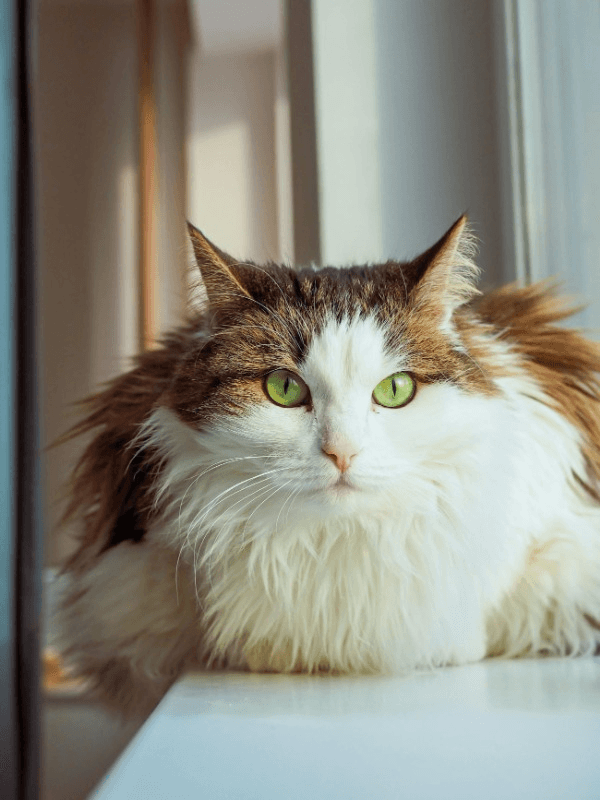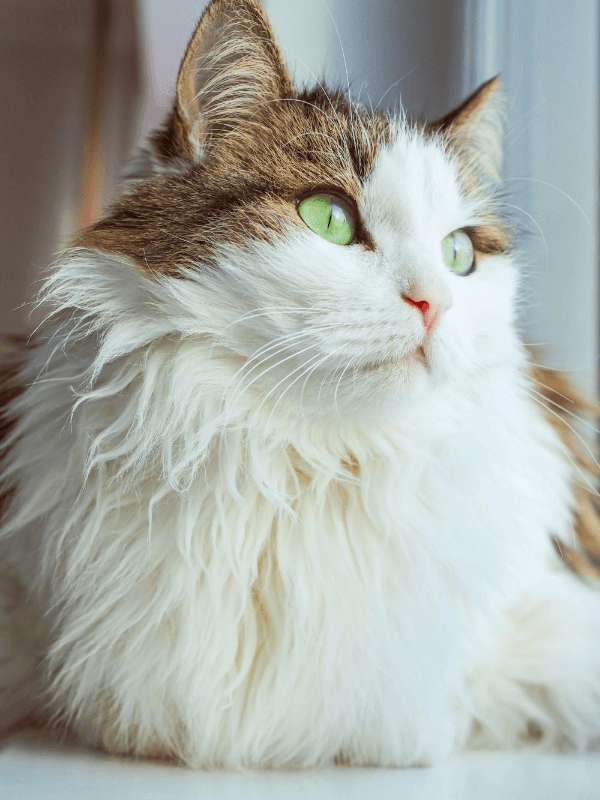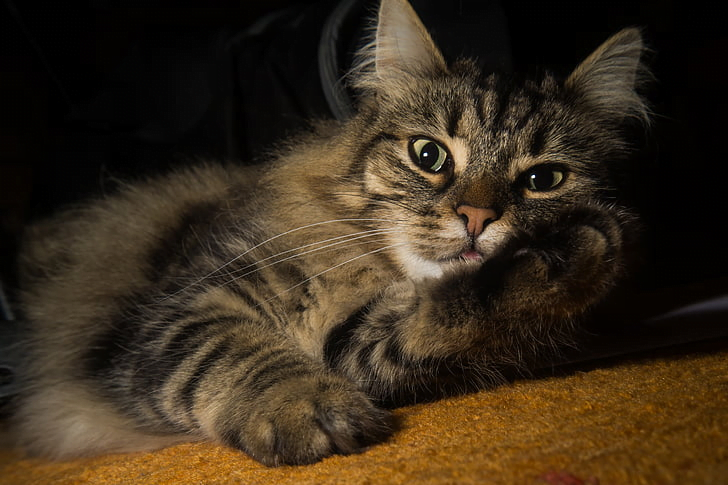The Norwegian Forest Cat is known for its thick fur and strong build. It comes from Norway and is well-suited for cold weather. These cats are loved for their gentle and playful nature.
They have a rich history and specific care needs. Knowing about these can help you appreciate these amazing animals better.
Key Takeaways
- Norwegian Forest Cats are a unique and robust breed, known for their thick fur and large size, making them a distinct addition to any family.
- Regular grooming is essential for their well-being, given their long, dense coats; brushing a few times a week helps prevent matting.
- These cats are known for being hearty and generally healthy, but like all breeds, they have specific health needs that require attention.
- They thrive in environments where they can explore and climb, so providing ample space and structures for physical activity is crucial.
- When considering adoption, it’s important to seek reputable breeders or adoption agencies that can provide health clearances and background information.
- Understanding and meeting the unique needs of a Norwegian Forest Cat can lead to a rewarding companionship for both the cat and its owner.
Breed Overview
History
The Norwegian Forest Cat has a rich history, dating back to the Viking Age. These cats were essential on Scandinavian farms, controlling rodents and believed to be mystical protectors by Norse legends.
In the 20th century, the breed was on the brink of extinction due to crossbreeding. Breeders worked hard to save the breed, leading to its recognition worldwide.
Today, these cats are celebrated globally. Their journey from Viking companions to beloved pets shows their resilience and charm.
Physical Characteristics
Norwegian Forest Cats are known for their large size and striking appearance. They have long, thick fur and bushy tails, perfect for the cold. Their coats come in various colors and patterns.
They have a strong build and features like tufted ears and paws that help them navigate snowy landscapes. These traits add to their beauty and adaptability.
Personality and Temperament
Norwegian Forest Cats are known for their gentle nature and deep bonds with family. They get along well with children and other pets. They are playful but often laid-back.
They are intelligent and curious, enjoying playful antics for hours. This makes them great companions for those seeking a loving yet independent pet.

Health And Care
Common Health Issues
Norwegian Forest Cats face genetic health risks. Hypertrophic cardiomyopathy (HCM) and hip dysplasia are common. Owners should watch for signs of these conditions.
Regular vet visits are important. They help catch health issues early. Keeping a healthy weight is also crucial to prevent obesity-related problems.
Dietary Needs
These cats need a high-protein diet. It supports their muscle mass and energy. A mix of dry and wet food is best for their hydration and dental health.
Watch the portion sizes to avoid obesity, especially in less active cats.
Exercise Requirements
Interactive play keeps Norwegian Forest Cats fit and sharp. They love climbing and scratching on cat trees and scratching posts. Safe outdoor access lets them explore and stay healthy.
Grooming
Regular brushing is a must for these cats. It prevents mats and controls shedding during seasonal shifts. Occasional baths keep their coat clean, lowering allergen levels in your home.
Don’t forget about nail trimming and ear cleaning. These routines are vital for their overall health.
Living with a Norwegian Forest Cat
Training and Socialization
Norwegian Forest Cats are remarkably intelligent, making them quite trainable. Clicker training coupled with positive reinforcement is highly effective for them. This breed thrives on rewards like treats or praise. Starting these methods early can lead to impressive results.
Early socialization plays a crucial role in their development. It helps them become well-adjusted adults. Introducing them to different people, animals, and environments when they’re young is key. They learn to be social and confident.
Interactive games not only strengthen your bond but also teach them basic commands. These activities keep their minds sharp and bodies active.
Environment
Given their size and energy levels, Norwegian Forest Cats need space. A cramped apartment might not be ideal for them. They love to climb and explore, so a spacious home suits them best.
Creating a safe, enriched environment is essential. Include high perches and hiding spots to satisfy their natural instincts. These features prevent boredom and promote physical activity.
Leaving them alone for too long can lead to separation anxiety. It’s important to ensure they have enough stimulation even when you’re not around.
Activities They Enjoy
These cats cherish activities that let them use their natural abilities. Climbing, exploring, and interactive play are among their favorites. Such activities cater to their adventurous spirit.
Puzzle toys and treat-dispensing games challenge their intellect. These toys mimic the hunting experience, keeping them engaged and satisfied.
Outdoor walks on a leash or in a secured area offer fresh air and new sights. This exposure is good for their mental health and keeps them fit.

Breeder Advice and Adoption
Choosing a Breeder
When looking for a Norwegian Forest Cat, finding a reputable breeder is crucial. These breeders prioritize the health and well-being of their cats. They conduct thorough health screenings on all breeding cats to ensure they are free from genetic diseases. It’s essential to ask for pedigree information and health clearances. This action confirms the cat’s genetic health and lineage.
Visiting the breeder’s facility is highly recommended. It allows you to see the environment in which the kittens grow up. A clean, spacious area with plenty of stimulation is a good sign. Observing the kittens’ behavior and temperament firsthand can also help gauge if they’re a good fit for your home, especially considering what was discussed about living with these majestic creatures.
Adoption
Adoption offers a meaningful alternative to buying from a breeder. Many shelters and rescue organizations specialize in Norwegian Forest Cats and can be excellent sources for finding your new companion. Adopting an adult cat comes with benefits like knowing their personality and health status upfront, which can be advantageous.
Before adopting, prepare questions about the cat’s history, health, and behavior. Shelter staff can provide valuable insights that help ensure you’re making an informed decision. Adopting not only gives a cat a second chance at life but also supports animal welfare organizations in their mission.
Final Remarks
The Norwegian Forest Cat, with its majestic appearance and friendly demeanor, has captured the hearts of many. This breed’s unique characteristics, health considerations, care needs, and adoption processes have been thoroughly explored to provide potential owners with a comprehensive understanding. They require specific attention to maintain their health and happiness, highlighting the importance of responsible pet ownership. Their adaptability makes them suitable for various living environments, yet they thrive on affection and companionship.
For those considering adding a Norwegian Forest Cat to their family, it’s essential to seek reputable breeders or adoption centers that prioritize the well-being of these animals. Engaging with communities of breed enthusiasts can also offer invaluable support and advice. Ultimately, ensuring the right fit between owner and pet contributes to a fulfilling relationship that enriches both lives. Let this be a call to action for all prospective cat owners: research thoroughly, prepare adequately, and embrace the joy these magnificent creatures bring.
Frequently Asked Questions
What is the lifespan of a Norwegian Forest Cat?
Norwegian Forest Cats usually live between 14 to 16 years. Taking good care of them, getting regular vet check-ups, and feeding them well can help them live longer.
How much grooming does a Norwegian Forest Cat require?
Norwegian Forest Cats need moderate grooming. Brushing them once a week helps prevent matting and reduces shedding.
Are Norwegian Forest Cats good with children?
Yes, they are great with kids. Norwegian Forest Cats are gentle and patient, making them perfect for families.
What health issues are common in Norwegian Forest Cats?
They can get hereditary health problems like hip dysplasia and heart diseases. It’s important to take them to the vet regularly for check-ups.
Can Norwegian Forest Cats adapt to living indoors?
Yes, they can live indoors if given enough space and things to do. They like to explore but also enjoy staying inside.
What should I consider when adopting from a breeder?
When getting a cat from a breeder, make sure they’re reputable. Check the health clearances of the kittens’ parents and ask about socialization. Read the contract carefully before you decide.
How active are Norwegian Forest Cats?
Norwegian Forest Cats are pretty active. They love to climb and play but also like to relax. Giving them different things to do can keep them happy.






0 Comments